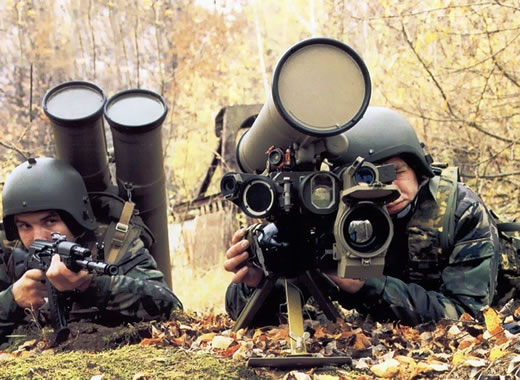
Above: this NLOW anti-tank weapon firing clearly show the delayed activiation of the rocket motor, ensuring the effects of flash, pressure acoustic overload are minimized on the user or on nearby troops. As many modern anti-tank weapons, NLOW can be fired from vehicles or from enclosures. Photo: Saab AB
New Guided Missiles, Programmable Munitions Are Required To Enhance The Infantry Precision Fire Effects
These modern missiles were designed exclusively as anti-tank weapons, providing dismounted infantry an effective counter-armor capability. However, in asymmetric warfare absent of heavily armored targets, these weapons may not be as effective. Hybrid Warfare, which combines elements of guerilla and ’empty battlefield’ with the high lethality of full scale war provides opportunities for the use of such weapons. For example, the Russian Metis M was used by the Hezbollah against the Israeli armor, and has, along with its larger sibling Kornet, had few engagements in Iraq as well. As mentioned above, Javelin missiles were fired at Iraqi T-72 tanks in 2003. Rather than engaging hard armor, these missiles are commonly used today against soft targets, in situations where dismounted infantry need an organic precision firepower, at extended range – reaching beyond other combat support weapons. Under such circumstances, despite its limitations, the guided anti-tank missile is the only organic weapon available to the unit.


Lightweight, man portable guided missiles currently available in military arsenals range from heavy, cumbersome and obsolete ‘first generation’ systems to lightweight, short range weapons designed primarily for self defense. The early generations are represented by the Russian AT-3 Sagger and the French Milan, The Sagger using ‘Manual Command to Line of Sight guidance and the Milan employing more advanced Semi-Automatic Command to Line of Sight – relieving the operator from ‘flying’ the missile – requiring him only to maintain the sight crosshair on target throughout the engagement. While this guidance system has proved effective, it is still vulnerable to counterfire, countermeasures or interference.
Although popular, such weapons rarely come to effect in modern warfare, as their directional High Explosive Anti-Tank (HEAT) warhead is not designed to defeat targets in the open or inside buildings. To provide such effect current shapd-charge warheads should be augmented with a ‘fragmentation sleeve’ or replaced by ‘Blast Fragmenting’ charges, which often come with multi-mode fusing, thus offering selectable, optimized effect against exposed targets, protected or personnel (hidden behind defilade or indoors). Such conversion was provided for the U.S. Marine Corps’ Predator missile. Other approaches are the use of dedicated missiles – for example, the SMAW II NE or the thermobaric charge used with one of the versions of Metis M1. Other limitations experienced in urban warfare are the inability of firing the weapons from enclosure (from vehicle turrets or through windows) due to the toxic fumes, excessive pressure and dangerous backblast.

















